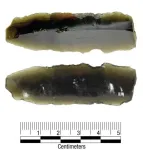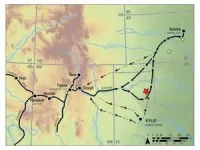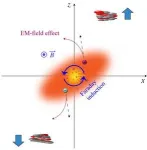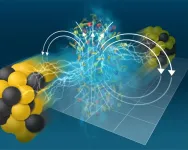(Press-News.org) DALLAS (SMU) – It’s a small piece of obsidian, just over 5 centimeters long, likely found on a hard-scrabble piece of ranchland in the Texas panhandle. But when SMU anthropologist Matthew Boulanger looks at it, he gets a mental image of Spanish explorer Francisco Vasquez de Coronado making his way across the plains more than 470 years ago in search of a fabled city of gold.
Boulanger believes that the flaked-stone tool with its sharp edge was likely dropped by a member of Coronado’s expedition, which included people indigenous to Mexico, as they trekked across parts of Texas, New Mexico, Arizona, Oklahoma and Kansas. His theory is backed by spectrometer analysis of the blade’s chemical composition, which ties it to Central Mexico’s Sierra de Pachuca mountain range, where indigenous people used obsidian to produce cutting tools until the Spanish conquest.
“This small unassuming artifact fits all of the requirements for convincing evidence of a Coronado presence in the Texas panhandle,” said Boulanger. “It is the correct form of artifact, it is fully consistent with other finds, the correct material, found in the correct location, and there are no indications of an intentional hoax.”
Boulanger, director of the Archeology Research Collections in SMU’s Dedman College of Humanities and Sciences, published his findings in the Journal of the North Texas Archeological Society, with co-author Charlene Erwin.
Other researchers have traced the path of Spanish explorers and indigenous people from Mexico across what is now the United States through the presence of central Mexican obsidian blades; because the blades were brittle, they were discarded along the way as they broke.
Boulanger concedes that where the blade was found is subject to conjecture, as he examined the artifact after the death of its collector. But a reconstructed map of Coronado’s expedition shows that the travelers likely passed by or through the ranch near McLean Texas where collector Lloyd Erwin grew up.
As a child, Erwin became interested in historical artifacts and started collecting items he found on the ranch. Years later, his daughter-in-law, Charlene, asked Boulanger to authenticate some of the obsidian pieces in a collection of artifacts that he had framed. Upon closer examination, Boulanger noticed a greenish tint to an obsidian piece that looked like it had been placed in the frame as an afterthought.
Using a spectrometer, Boulanger traced the obsidian to Central Mexico’s Sierra de Pachuca mountain range, where indigenous people widely used obsidian to produce tools until the Spanish Conquest.
So how did an obsidian blade from Central Mexico end up in the Texas Panhandle? There is no clear evidence for a trade network that would have connected Indigenous peoples of the Texas Panhandle to those living in Central Mexico prior to the Spanish Conquest of Mexico in the early 1500s.
Boulanger offered three theories for consideration: young Lloyd Erwin obtained the blade through trade or exchange of artifacts with other collectors, the blade is a hoax to garner attention to Erwin and his collection, or the blade was genuinely found in Texas by Erwin and is indeed an archaeological find. After piecing together Erwin’s travels and interviewing his family, Boulanger believes the third hypothesis is correct.
He suspects the obsidian blade was carried northward by one of the many people indigenous to Mexico who accompanied the Coronado expedition to Quivira, near modern-day Salina, Kansas. If more corroborating evidence is uncovered near where Erwin found the blade, it could provide archaeologists more proof the artifact is part of a Coronado-related site and a clue to the expedition’s trail.
“Because we know Erwin found the knife on his family ranch, we can speculate that someone on Coronado’s expedition discarded it,” said Boulanger. “When I talk to people collecting artifacts, I tell them to document where they find objects. Because most of us now have mobile phones, we can record GPS coordinates easily. You can now provide archeologists precise locations, which helps them authenticate artifacts and possible lead to more discoveries.”
About SMU
SMU is the nationally ranked global research university in the dynamic city of Dallas. SMU’s alumni, faculty and more than 12,000 students in eight degree-granting schools demonstrate an entrepreneurial spirit as they lead change in their professions, communities and the world.
END
Artifact could be linked to Spanish explorer Coronado's expedition across Texas Panhandle
Could a family’s obsidian blade be a clue to the expedition’s trail?
2024-02-23
ELSE PRESS RELEASES FROM THIS DATE:
Do’s and don'ts with direct oral anticoagulants
2024-02-23
Direct oral anticoagulants (DOACs) are a common treatment for patients with a wide variety of cardiovascular conditions. DOACs are the preferred treatment over vitamin K antagonists (VKAs) for many patients with atrial fibrillation or venous thromboembolism, since the latter would have a higher risk of intracranial bleeding and more complex dosing routine. However, new research suggests that DOACs should not be the first line of treatment for every patient who need to treat or prevent blood clots. A systematic overview from researchers at Brigham and Women’s Hospital, a founding member of Mass General Brigham, discusses the efficacy ...
Super strong magnetic fields leave imprint on nuclear matter
2024-02-23
UPTON, NY—A new analysis by the STAR collaboration at the Relativistic Heavy Ion Collider (RHIC), a particle collider at the U.S. Department of Energy’s (DOE) Brookhaven National Laboratory, provides the first direct evidence of the imprint left by what may be the universe’s most powerful magnetic fields on “deconfined” nuclear matter. The evidence comes from measuring the way differently charged particles separate when emerging from collisions of atomic nuclei at this DOE Office of Science user ...
TMEM208 variants cause a new developmental disorder
2024-02-23
A recent study conducted in the lab of Dr. Hugo J. Bellen, distinguished service professor at Baylor College of Medicine and principal investigator at the Jan and Dan Duncan Neurological Research Institute at Texas Children’s Hospital, has discovered a biological role of a specific transmembrane protein called TMEM208.
The study, published in the Proceedings of the National Academy of Sciences, showed that a majority of fruit flies lacking this gene do not survive, and the few that do survive have many developmental defects. Similarly, a child with variants ...
Researchers explore whether gut microbes cause some COVID-19 patients to have higher blood clot risk
2024-02-23
A gut microbial metabolite called 2-methylbutyrylcarnitine (2MBC) plays a role in exacerbating thrombosis -- the formation of blood clots – researchers report February 23rd in the journal Cell Metabolism. The results also revealed that 2MBC is accumulated in individuals with COVID-19, potentially explaining why these patients are at increased risk of thrombosis.
“Our study provides mechanistic insight by implicating 2MBC as a metabolite that links gut microbiota dysbiosis to elevated thrombotic ...
Childhood factors associated with unnatural death through midadulthood
2024-02-23
About The Study: In this urban population-based cohort study of 2,180 participants, no modifiable risk factors of mortality at the level of the individual (e.g., depression or anxiety and substance use) or the family (e.g., household education level) were identified. However, the degree of neighborhood poverty in early childhood was significantly associated with death by unnatural causes (death due to unintentional injury, suicide, and homicide) in early adulthood, suggesting that economic policies are needed to advance health equity in relation to premature mortality.
Authors: Holly C. Wilcox, Ph.D., of the Johns Hopkins Bloomberg ...
Severe COVID-19 in vaccinated adults with hematologic cancers in the Veterans Health Administration
2024-02-23
About The Study: In this case-control study including 6,122 patients with hematologic cancers and SARS-CoV-2 infection, odds of severe COVID-19 remained high through mid-2022 despite vaccination, especially in patients requiring treatment.
Authors: Paul A. Monach, M.D., Ph.D., of the VA Boston Cooperative Studies Program in Boston, is the corresponding author.
To access the embargoed study: Visit our For The Media website at this link https://media.jamanetwork.com/
(doi:10.1001/jamanetworkopen.2024.0288)
Editor’s Note: Please see the article for additional information, including other authors, author contributions ...
Recreational marijuana legalization and workplace injuries among younger workers
2024-02-23
About The Study: In this study, recreational marijuana laws that allow recreational marijuana sales were associated with a 10% increase in workplace injuries among individuals ages 20 to 34. The findings are consistent with the hypothesis that recreational marijuana impedes cognitive function and care among younger workers.
Authors: Joseph J. Sabia, Ph.D., of San Diego State University, is the corresponding author.
To access the embargoed study: Visit our For The Media website at this ...
New study identifies 13 strategies for advancing racial and ethnic equity in the academic health sciences
2024-02-23
BOSTON - Amid continued debate over how to advance diversity and equity in higher education following the Supreme Court’s decision striking down affirmative action, researchers from Massachusetts General Hospital and Northeastern University today issued a “roadmap” of strategies to help academic health institutions maintain their commitments to racial and ethnic diversity among their students, staff, and faculty in academic health sciences.
Their recommendations, published in JAMA Health Forum, outline 13 evidence-based strategies for increasing racial and ethnic equity in graduate-level health programs.
“This ...
School focus on grades, test scores linked to violence against teachers
2024-02-23
COLUMBUS, Ohio – Violence against teachers is likely to be higher in schools that focus on grades and test scores than in schools that emphasize student learning, a new study has found.
Researchers surveyed over 9,000 U.S. teachers shortly before and during the height of the COVID-19 pandemic about their perception of the instructional emphasis in their schools. Participants also reported whether they had been subjected to physical, verbal or property violence – by students, parents, colleagues and/or administrators.
Results ...
Genetic signature may predict response to immunotherapy for non-small cell lung cancer
2024-02-23
A new study identified a set of 140 genes that may help predict enhanced disease-free survival in patients with non-small cell lung cancer (NSCLC) treated with a combination of immunotherapy and low-dose radiation. The results, published in Cell Reports Medicine on Feb. 23, suggested that this “gene signature” could be used to identify a subclass of lung tumors that is more likely to be eradicated by immunotherapies.
Immunotherapy has saved countless lives but only 20 to 25 percent of patients respond to this treatment that activates a person’s ...
LAST 30 PRESS RELEASES:
A new, cleaner way to make this common fertilizer
Fire-safe all-solid-state batteries move closer to commercialization
Disinfecting drinking water produces potentially toxic byproducts — new AI model is helping to identify them
Unplanned cesarean deliveries linked to higher risk of acute psychological stress after childbirth
Healthy aging 2026: fresh pork in plant-forward diets supported strength and brain-health biomarkers in older adults
Scientists identify pre-cancerous states in seemingly normal aging tissues
Itaconate modifications: mechanisms and applications
Potential tumor-suppressing gene identified in pancreatic cancer
Winners of the 2026 Hill Prizes announced
Autonomous AI agents developed to detect early signs of cognitive decline
Study finds ocean impacts nearly double economic cost of climate change
Increased deciduous tree dominance reduces wildfire carbon losses in boreal forests
Researchers discover how a respiratory bacterium obtains essential lipids from the human body and targets fat-rich tissues
Locust swarms destroy crops. Scientists found a way to stop that
More resources and collaboration needed to support prevention and treatment of obesity
Two types of underconfidence linked to anxiety and gender
Insects are victims too: Global study shows impacts of invasive alien species on populations
Pioneering natural, degradable polymer capsules
Forestry is becoming digital and automated
Maternity baby deaths much higher in northern England than in the South
Mosquitoes’ thirst for human blood has increased as biodiversity loss worsens
The stop-smoking medication varenicline may also work for cannabis use disorder
Potential new treatment for sepsis
Study reveals how many hours of video games per week might be too many
Electrospinning for mimicking bioelectric microenvironment in tissue regeneration
Home fingertip oxygen monitors less accurate for people with darker skin tones
Six weeks in a cast no less effective than surgery for unstable ankle fractures
Precautionary approach to alcohol-free and low alcohol drinks needed to protect public health, say experts
Gas-atomized Ca–Mg alloy powders produce hydrogen simply by adding water — high-efficiency hydrogen generation at room temperature
British redcoat’s lost memoir reveals harsh realities of life as a disabled veteran
[Press-News.org] Artifact could be linked to Spanish explorer Coronado's expedition across Texas PanhandleCould a family’s obsidian blade be a clue to the expedition’s trail?



